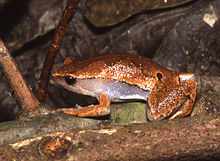Bolivian bleating frog
| Bolivian bleating frog | |
|---|---|

| |
| Scientific classification | |
| Domain: | Eukaryota |
| Kingdom: | Animalia |
| Phylum: | Chordata |
| Class: | Amphibia |
| Order: | Anura |
| Family: | Microhylidae |
| Genus: | Hamptophryne |
| Species: | H. boliviana
|
| Binomial name | |
| Hamptophryne boliviana (Parker, 1927)
| |
| Synonyms[3] | |
| |
The Bolivian bleating frog (Hamptophryne boliviana) is a frog that lives in Bolivia but also Venezuela, Peru, French Guiana, Guyana, Suriname, Brazil, Ecuador, and Colombia. It lives in the Amazon River Basin. They sometimes live with tarantula spiders.[4][3][1]
Appearance[change | change source]
The adult male frog is about 3.2 cm long from nose to rear end. The adult female frog is 3.2 to 3.8 cm long.[1]
This frog is mostly brown with a white or pale belly. The brown color on its back is much lighter in color than the skin on the sides of its head and body. There is a medium-brown pattern on the middle of its back.[1] This frog looks like a dead leaf.
Actions[change | change source]
This frog hides during the day and looks for food at night. It mostly stays on the ground instead of climbing trees like a tree frog or staying the water like a swimming frog. It mostly stays in primary forest, though people sometimes see it in secondary forest or near the edges of forests. People see them sitting on small plants.[1]
This frog has many young at once. The male frogs go to ponds where the water is not deep. They go to ponds that are there all year and to ponds that dry up for part of the year. The male frogs sing together for the females. Some females can lay more than 2000 eggs at one time.[1]
The tadpoles are about 3.0 cm long.[1]
This frog mostly eats ants, but it will also eat beetles, earwigs, termites, other mites, and larvae.[1]
Predators[change | change source]
Tarantulas can eat this frog.[5] So can the toad Ceratophrys cornuta.[1]
Tarantulas[change | change source]
This frog sometimes lives with tarantula spiders in the species Xenesthis immanis. Scientists think that the frogs eat ants that would eat the tarantula's eggs.[1][4]
Name[change | change source]
This species is named after Mr. Eijiro Nagao. Mr. Nagao was President of Japan's Marusan Securities Co. Ltd. The Nagao Environmental Foundation gave scientists the money to study amphibians in Sri Lanka.[1]
References[change | change source]
- ↑ 1.00 1.01 1.02 1.03 1.04 1.05 1.06 1.07 1.08 1.09 1.10 Diego A. Ortiz (November 27, 2013). "Hamptophryne boliviana". Amphibiaweb (in Spanish). University of California, Berkeley. Retrieved January 29, 2022.
- ↑ IUCN SSC Amphibian Specialist Group (2004). "Bolivian Bleating Frog: Hamptophryne boliviana". IUCN Red List of Threatened Species. 2004. The IUCN Red List of Threatened Species: e.T57821A11688802. doi:10.2305/IUCN.UK.2004.RLTS.T57821A11688802.en. Retrieved January 29, 2022.
- ↑ 3.0 3.1 "Hamptophryne boliviana (Parker, 1927)". Amphibian Species of the World 6.0, an Online Reference. American Museum of Natural History. Retrieved January 27, 2022.
- ↑ 4.0 4.1 Darren Naish (May 16, 2015). "Tiny Frogs and Giant Spiders: Best of Friends". Scientific American Blogs. Retrieved January 29, 2021.
- ↑ Rudolf von May; Emanuele Biggi; Heidy Cárdenas; M. Isabel Diaz; Consuelo Alarcón; Valia Herrera; Roy Santa-Cruz; Francesco Tomasinelli; Erin P. Westeen; Ciara M. Sánchez-Paredes; Joanna G. Larson; Pascal O. Title; Maggie R. Grundler; Michael C. Grundler; Alison R. Davis Rabosky; Daniel L. Rabosky (February 28, 2019). "Ecological interactions between arthropods and small vertebrates in a lowland Amazon rainforest" (PDF). Amphibian and Reptile Conservation. 13 (1): 65–77. Retrieved January 27, 2022.

